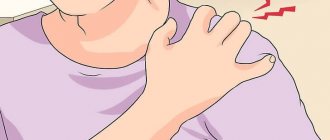Earwax is a common problem in children where excessive amounts of earwax accumulate in the ear canal, compacting and forming a dense lump that causes discomfort and impairs hearing. It can appear at any age, even a year or earlier. Despite the fact that the disorder is not considered severe, it can easily lead to the development of serious complications in the absence of proper and timely treatment. It is better to entrust the removal of the plug to a specialist.
Earwax in its composition is a mixture of the secretion of sulfur, sebaceous and sweat glands, as well as dead epithelial cells located in the ear canal. This substance contains immunoglobulins, which suppress the development of pathogenic microflora, and bacteria necessary for the body.
The production of secretion occurs constantly, as it is necessary to cleanse the ear canal from harmful bacteria, viruses and dust. Normally, sulfur itself is removed from the ear canal when chewing. If for some reason the process of outflow of sulfur is disrupted, it begins to accumulate inside and, gradually becoming denser, forms a larger or smaller plug. Significant plugs completely block the ear canal and cause severe hearing impairment.
Reasons for appearance
The formation of ear secretion accumulation can occur for many reasons, which is why the disease is widespread. Doctors name the following as the main reasons for the appearance of the pathological condition:
- individual structural features - sometimes the ear canal turns out to be quite narrow, which is why the sulfur from it, even with slightly increased thickening, loses the ability to fully release out, and its compaction begins;
- mistakes when cleaning the ears - if cotton swabs or similar objects are used, they cannot remove the secretion, but only compact it. This improper care practice is one of the main reasons why children get into trouble;
- inflammation of the ear canal due to injury - in this case, local swelling disrupts the process of sulfur secretion and leads to it compacting and drying out. Injuries most often occur due to improper ear cleaning, as well as swimming in open water;
- excessively frequent ear cleansing – this can cause the ear canals to become catastrophically dry. To moisturize their epithelium, the body begins to actively produce sulfur, which, due to the large amount, does not have time to be released in sufficient volume and accumulates, becoming denser;
- prolonged stay in a room with dry air - under such conditions, the tissues in the ear begin to dry out, and large quantities of sulfur are required to moisturize them. The disruption process is similar to the previous cause of the problem;
- the presence of a foreign body - it mechanically blocks the channel and does not allow the secretion to be released. Its production does not stop, and it begins to quickly thicken, forming large plugs that can cause especially severe discomfort. This cause of the disease, as a rule, occurs in preschool children, who, out of curiosity, may put an object in their ear.
Whatever causes the pathology, it must be eliminated competently. It is also important to make sure that the problem is associated precisely with the accumulation of sulfur, and not with any tumor process, the symptoms of which at first are almost the same. A wax plug in a child’s ear can also sometimes have similar symptoms to a large foreign body.
A lot of wax in a child's ears
The first step is to find out why secretion is released in the auditory canal. Sulfur serves as protection against the penetration of dust, lint and other particles that can damage human hearing. On the thin skin that covers the ear canal, there are 2000 sulfur glands, which produce sulfur. Its consistency resembles an ointment; it can be yellow, darker or lighter in color. There may also be an odor, the intensity and nature of which depends both on the characteristics of the body and the presence of inflammatory, infectious and other pathologies. It is important to understand how processes occur in a child’s body, why this or that phenomenon occurs, and for what reasons so much wax is released in a child’s ears. Is this evidence of diseases that should be paid special attention to?
Causes of excessive secretion production
A large amount of secretion can be a consequence of a variety of factors. So why does a lot of wax form in the ears? Let’s study the reasons. These primarily include:
- inflammation;
- being in a noisy place or room;
- fungal infection, etc.
It is quite natural that children have much less substance than adults. And most often, the discrepancy between the volume and the baby’s age indicates the characteristics of the body, metabolic processes and problems. So, why does a lot of wax form in the ears?
Inflammation
Sulfur secretion contains squalene, alkaloids, cholesterol, lanosterol, etc. Some of these substances have bactericidal and antimicrobial properties. And when there is a danger of developing inflammation or an infection has entered, a lot of wax begins to be produced in the ears.
The discharge itself begins when the child is a couple of days old and does not stop throughout life.
Excessive enthusiasm for hygiene procedures
If there is a large amount of wax in a child’s ears, then it makes sense to assume that his compassionate mother is too keen on cleaning the ear canal. After all, the more sulfur is removed, the more it is produced - this is the body’s reaction. A vicious circle arises - the secretion is removed again, it accumulates again. The only way out is not to overdo it and don’t get carried away with cleaning your baby’s ears.
Dirty room
Sulfur acts as an ear canal cleaner. It traps particles of dust and skin and pushes them out of the passage.
The atmosphere in the room also influences the formation of a large volume of secretion. If it is too dry or humid, it is over-produced - this is why a child has a lot of wax in his ears. To eliminate the problem, you need to ventilate the room more often.
Tinnitus
Vitamin deficiency, dizziness, lack of oxygen and other conditions lead to the production of a lot of wax in the ears of infants. Any, even inaudible noise, hum or whistle represents an irritant from soda, to which the sulfur glands react.
Dermatitis, fungal infection
In case of skin diseases, a process of increased exfoliation of the epithelium, which is part of the sulfur secretion, occurs. And as a reaction to the accumulation of “garbage,” the body releases sulfur to fix and remove pollution.
Otitis
The inflammatory process could be a consequence of the accumulation of wax or blockage of the ear canals. Children often have narrow passages and even a small amount of the substance can cause blockage, which leads to inflammation. In addition, otitis media occurs when cold air flows into the ear and the body becomes hypothermic. In this case, it is also necessary to pay attention to the color and consistency of the sulfur.
Purulent
Sigal about suppuration or fungal infection, which is characterized by an unpleasant odor of secretion.
Furuncle
If a purulent boil is opened by parents or the baby himself, the process is accompanied by severe pain. It is necessary to urgently consult a doctor and take measures to relieve pain and disinfect the passage with appropriate drug treatment.
Puncture
The reason for a lot of wax in a child’s ears can be a dangerous situation - perforation, that is, a puncture of the eardrum. Urgent medical attention and treatment is required.
How to deal with the problem
The child's body is very fragile and self-medication is strictly prohibited for the child. And even such a simple procedure as cleaning your ears can end in big trouble. Unfortunately, statistics indicate that the use of cotton swabs and matches with cotton wool leads to hearing loss in children. Therefore, the main rule for caring for a baby’s ears is to consult an experienced specialist and exclude any accessories, only one thing - light washing at the very edge of the ear canal.
Cork
A consequence of the large accumulation of secretion in the ear canal is cerumen plug. Of course, parents absolutely cannot remove it themselves. But there is another problem - the baby cannot share and the pathology does not immediately appear. It’s a different matter if there is a lot of wax in the ears of an adult due to blockage. This is why there is a regular visit to the pediatrician and a complete examination of the baby.
At an older age, the presence of a traffic jam can be signaled by such points as:
- dizziness;
- nausea, vomiting;
- lack of coordination;
- child's complaints of headache, ear pain.
If you do not pay attention to the condition of your ears and do not get rid of the wax plug, there may be consequences - inflammation, otitis media, severe headaches and ear pain.
Treatment
The otolaryngologist must take measures to eliminate the causes of excessive sulfur secretion. If an inflammatory or infectious process is detected, medications of the appropriate type are prescribed. The specialist must wash the formed plug using hydrogen peroxide, antibiotics or special solutions.
Important: you cannot use heated vegetable oil to treat and cleanse your ears - it is only suitable for external use.
To prevent excessive release of sulfur, it is enough to clean the edges of the canal twice a day with water and a cotton swab. It is strictly not recommended to penetrate deep into the ear canal.
So, there are many reasons for the formation of a large amount of secretion in the ears. These can be harmless phenomena or serious illnesses. Therefore, to understand why there is a lot of wax in the ears, the main and important step for parents should be to visit a doctor and eliminate any prerequisites for deterioration of the child’s hearing.
Related posts:
- Anemia in children and adults: symptoms and causes of anemia
- Miliaria in adults: causes and treatment
- Bronchitis: symptoms, causes and treatment in adults
- Intestinal colitis: symptoms and treatment tactics in adults
- Treatment of conjunctivitis in adults
- Lots of earwax
- Is it worth trying to save the family for the sake of the child?
- How to improve the relationship between a child and stepfather
Is it possible to determine by eye?
If the plug is not deep, it can be seen when examining the ear. In this case, it will be noticeable that the ear canal is completely blocked by a formation of black, brown, gray or yellowish color. When an inflammatory process occurs, purulent discharge or blood may be noticed. Trying to pick such plugs is strictly prohibited. Such an attempt to help the child will only cause harm. To eliminate the formation, you need to consult a doctor or, as a last resort, use products purchased at a pharmacy at home.
It is useful for all parents to know what wax plugs look like in children. In the photo you can see the accumulation of wax in the ear of an infant and an older child.
How to understand that a sulfur plug has appeared
Diagnosing wax plugs is not as simple as it might seem at first glance. Even if there is quite a lot of sulfur, it may not show itself in the form of additional symptoms. Discomfort appears only when the ear canal is completely blocked. Hearing begins to decline. Exposure to water during bathing causes the plug to swell and, as a result, the ability to hear sounds is lost.
Other symptoms of wax plugs in children:
- noise in ears;
- nausea;
- dizziness;
- sensation of fullness in the ears;
- headache.
Sulfur plugs can negatively affect the functioning of the nervous and cardiovascular systems. Hearing loss is far from the most dangerous complication for a child.
Diagnosis of wax plugs is made by pediatricians during a visual examination of the patient. The final diagnosis is made by an otolaryngologist. The doctor assesses the stage of the pathology, checks for the presence of other diseases, foreign bodies in the ears, etc.
Kinds
Doctors distinguish three types of plugs depending on the consistency of the secretion they consist of. This also partly determines how the foreign object will be removed from the ear canal. It is important that there is no tissue damage during treatment, otherwise there is a high risk of infection. Ear plugs in children can be as follows:
- pasty - their color ranges from light yellow to deep yellow with an orange tint. They are soft, so removing such a foreign body is quite simple. It cannot damage tissue and does not cause pain when removed;
- plasticine-like - denser, dark brown in color, they can cause pain when removed, and if handled carelessly, they can injure tissue. Such plugs develop from pasty ones if they are not removed in time;
- hard - their color is black, they are especially dense and easily lead to damage even with the most careful removal. In some cases, local anesthesia may be required before removal. They most often form if the pathology was not promptly paid attention and treatment was not carried out.
What type of formation occurs in a particular case is determined by the otolaryngologist after examining the patient. Also, based on the examination, it is determined how the object will be removed from the ear, as well as whether there are any local complications of the pathology.
Removing a traffic jam at home
Removing wax plugs from a child’s ear at home is not difficult if you follow certain recommendations. There are several simple ways to remove tumors that are suitable even for parents who have never encountered such a problem.
Drops for removing blockages
In the pharmacy chain you can buy ear plug drops for children. The most commonly used drug is A-Cerumen. The child is placed on his side, the ear is generously instilled with medicine and left to lie down for several minutes. Then the child is asked to turn over to the other side, and the liquid flows out of the ear, along with the softened plug. The pillow must first be covered with soft cloth or gauze in several layers. Before using drops to dissolve sulfur plugs, you need to carefully read the attached instructions and strictly follow them.
Vegetable oil
To remove traffic jams yourself, you can also use vegetable oil. It is heated in a spoon to a comfortable temperature and instilled into the ear twice a day, 2 drops. The course of such treatment is 5 days, usually during this time the plug becomes soft and comes out of the ear without difficulty. If the tumor does not come out after treatment, it is necessary to show the child to an otolaryngologist. Camphor oil will be more effective, but if you don’t have it on hand, then regular sunflower oil will do.
Hydrogen peroxide
Hydrogen peroxide in the ear helps children get rid of traffic jams. This medicine is heated in the hand to a comfortable temperature and instilled into the ear canal up to 3 times a day, a few drops. Usually, after a couple of days, the sulfur plug comes out easily.
Garlic compress
It is good at removing plugs from a child’s ear and using a specific compress. This folk method of treatment is considered effective, but not entirely safe, so it is better to consult a doctor. Take half a clove of garlic and grind it to a paste. Mix with three drops of camphor oil. A gauze flagellum is moistened with the resulting composition and inserted into the ear canal. This compress can be kept for no more than 10 minutes. Garlic will cause a strong burning sensation, so the child may be capricious. Afterwards, the flagellum is removed, and the ear is thoroughly washed with a syringe.
Diagnostics
Diagnosis of pathology is not difficult. In young children, plugs are often discovered accidentally by a pediatrician during a general examination. Parents may not know about the problem, since the child does not yet speak and cannot show that he has a violation. Usually, after visiting the pediatrician on the same day, it is recommended to visit an otolaryngologist to clean the ear and check for the presence of complications of the pathology.
A specialized specialist conducts an examination of the patient, during which the presence of sulfur accumulation is not only diagnosed, but the density of the lump and general hearing impairment are determined. Examination with an otoscope allows you to determine the size of the plug and the presence of local consequences from it. Using a special probe, the density of the cluster is determined. Also, the otolaryngologist must determine whether there are tumor formations or foreign objects in the ear canal, which are causing the accumulation of secretions.
In cases where the presence of complications is detected, the doctor, after removing the wax plug, prescribes the necessary therapy. It can be general or local. The patient usually does not require hospitalization. Only if severe consequences of the pathology appear at an early age can a specialist recommend leaving the child under medical supervision.
When the color of earwax indicates a problem in the body
Sometimes you may notice a change in the color of the discharge from the ear; these changes are associated with the appearance of health problems. If you have any disease, the color of the discharge from the ear may be:
Black sulfur can signal the presence of the following diseases:
- fungal infection;
- wounds;
- foreign body in the ear;
- severe ear contamination.
If you see that earwax is black or dark brown in color, you should immediately contact an otolaryngologist so that the doctor can make an accurate diagnosis and prescribe treatment. If the cause of this color is a foreign body or severe contamination of the auricle, then the doctor and other medical personnel will remove the foreign body or clean the auricle of contamination. You should not try to get rid of a foreign body yourself, since you can cause irreparable damage to the hearing aid, which may result in partial deafness or complete deafness. If the cause was illness or infection, then the help of a qualified doctor is necessary.
Prevention
In order to protect your child from ear problems, it is necessary to remember about preventive measures against the accumulation of wax. Ear cleaning is carried out once a week, not more often. To do this, use only special cotton swabs designed for cleaning children's ears. Movements during the procedure should be circular without pressure. If it is noticed that wax has begun to separate poorly, it is necessary to use special drops to care for the ear cavity in children. They have a gentle effect and dissolve the thickened secretion, allowing it to easily flow out. Which specific drug is better to choose, you need to consult with a pediatrician or otolaryngologist, since not all drugs are equally harmless.
Preventative measures also include careful bathing of the child. It is important that water does not get into the ear. Because of this, the sulfur will begin to increase in volume, and the ear canal will become blocked. If water does get in, you need to remove it using a cotton swab.
Solutions to the problem
Since the reasons that cause excessive release of wax from a child’s ear can be completely different, the methods for eliminating the problem also differ from each other. The most common cause of the symptom is the formation of wax plugs. For children, it is best to solve this problem by contacting an ENT specialist, since their ear canal is different from that of an adult, and therefore it is much easier to cause damage as a result of inept actions.
To remove wax plugs, children most often undergo ear rinsing. For this, a special Janet syringe is used. With its help, contaminants are washed out into the tray-stand. The procedure can only be carried out by a qualified specialist, since an incorrectly applied flow of water will either not remove the plug or may damage the eardrum.
If you notice that too much discharge has accumulated in the ear, despite regular toileting, an unpleasant odor and other symptoms of inflammation have appeared, you need to consult a pediatrician. If pus flows instead of sulfur, it means that the infection has begun to actively develop. To eliminate it, anti-inflammatory and bactericidal drugs are prescribed. In some cases, antibiotics are required. For drying, use hydrogen peroxide or boron powder. New medications can only be introduced after consulting a doctor.
It is also important to treat a runny nose, because it can provoke disruption of the normal state of the hearing organs. With the chronic development of nasopharyngeal diseases, this is a common occurrence.
If no pathological processes are detected in the ears, you simply need to ensure sufficient hygiene of the hearing organs. For very young children, parents should remove discharge. At school age, responsibility for ear health is partially shifted to the child himself. He needs to explain the intricacies of the procedure for safely cleaning the ear canal. To prevent excessive penetration, it is recommended to use special cotton swabs with a limiter.
You cannot decide spontaneously which treatment is right for your child. Therapy can only be prescribed by a pediatrician or ENT doctor after a thorough examination of the small patient. If the processes that caused the increase in the volume of sulfur secretions are not pathological, there is nothing to worry about. After some time, the situation will normalize on its own. If germs or accumulations of contaminants are detected, appropriate measures should be taken to eliminate them. A competent and comprehensive approach to the problem is a guarantee of a quick recovery for the baby. Therefore, we recommend that you immediately make an appointment with an ENT doctor for a consultation.
What it is?
In medicine, an ear plug is called wax: we are talking about the ENT pathology of the same name, the essence of which is the complete or partial blockage of the external auditory canal with a large amount of accumulated earwax. This sulfur is the result of the work of sulfur glands, which are located in the cartilaginous part of the outer ear. It is produced so that the eardrum does not dry out, so that the ear is naturally kept clean and tidy. Sulfur is mixed with the secretion of the sebaceous glands, as well as with dust particles and exfoliated epithelium. This is exactly the composition of earwax.
When a person sucks, swallows, speaks, chews, the temporomandibular joints come into motion, and it is this movement that allows the accumulation of wax to leave the ear quite naturally. This process is daily, no one pays attention to it.
A plug begins to form when this natural cleansing of the ear becomes difficult for some reason. Then it accumulates and gradually clogs the auditory canal, which is manifested by characteristic signs.
Ear plugs come in different varieties. It all depends on what consistency they have. Highlight:
- paste-like plugs (light and yellowish, rather soft);
- plasticine-like (brown, thick and viscous);
- hard (dry, dark, sometimes almost black).
Soft plugs, if not removed in time, tend to turn into a hard, dry form. If the dry plug is not removed for a long time, it can cause bedsores in the bone area.
- What do wax plugs look like in a child’s ears and what can be done about them at home?
Treatment options
If children have sulfur plugs, parents should seek help from an ENT doctor, who will choose the appropriate removal method and carry out the procedure using special instruments.
In treatment and prevention, agents are also used in the form of solutions, drops and sprays that improve the general condition of the ear canal and facilitate the release of wax.
Qualified medical care
There are two ways to mechanically remove wax plugs.
Wet
The ear canal is washed. For a child in a sitting position, pulling the ear down and back, a certain amount of warm water or a special solution is injected into the canal using a Janet syringe under pressure to soften the plug and bring it out. The jet is directed along the back or upper wall of the passage so that there is no air lock.
To drain the water, a metal tray is used, which is placed on the patient’s shoulder on the side of the ear being washed. The procedure is painless, lasts a few minutes, and only a slight tinnitus is felt. Instead of a syringe, it is better to use an electronic irrigator, which pulses the solution and regulates the jet pressure, making the process safe and comfortable. If the sulfur plug is dense, then a few days before washing it needs to be softened.
Rinsing the ear with a stream of warm water using a Janet syringe is a quick and painless procedure
Dry
Used in the presence of perforation of the eardrum, chronic and purulent otitis. The procedure is carried out using a vacuum aspirator, which, like a vacuum cleaner, pulls the sulfur plug out of the canal entirely or in parts.
When the above methods do not lead to results, the plug is removed with a special tool - a probe with a hook at the end. The instrumental method (curettage) is associated with the risk of injury to the eardrum; it is used under anesthesia, after which antibiotics are injected into the ear canal.
Removing a traffic jam at home
How to get wax plug if it cannot be removed mechanically? A small child will not be able to withstand the washing procedure, since it will not be possible to keep him in a motionless position. The plug can be dense and deeply located. In these cases, cerumenolysis is used, a method based on the dissolution and spontaneous removal of sulfur.
Means to soften and remove wax from the ear canal include:
- Remo-Vax drops and spray are a product based on allantoin, approved for use from the moment of birth. 15 drops of the drug are instilled into the ear. Pulling the lobe upward, massage it a little in a circular motion. Place a piece of cotton wool inside and leave for 20 minutes. The product is used for up to 5 days.
READ ALSO: A child’s ear hurts: what to do at home?
- How to remove an ear plug at home? Earwax plugs in the ears - what to do?
- 3% solution of hydrogen peroxide (for hypersensitive skin, dilute with water in equal quantities). Laying the child on his side, pulling the ear down and back, 10 drops of warm solution are injected into the ear canal along the back wall and left for 10 minutes. Hydrogen peroxide will foam and hiss and may cause slight hearing loss. After time has passed, the head is tilted, allowing the liquid to drain, and the ear canal is dried from the outside with a cotton swab. The procedure is repeated up to 6 times a day.
- A-cerumen drops in disposable dropper bottles of 2 ml. Used from the first days of life. 1 ml of the product is instilled into the ear and left for 1 minute, after which it flows out along with the contents of the ear canal. Apply morning and evening for 3-4 days.
- Sodoglycerin drops, which are prepared in a pharmacy. 5-10 drops in 15 minutes will soften the wax plug, and when you tilt your head, it will flow out of the ear.
- Ear candles are strips of fabric impregnated with wax, rolled into a tube. One end is inserted into the sore ear, and the other is set on fire. After combustion to a certain point, the candle is extinguished. Earwax is heated by the heat generated during combustion, sticks to the tube and is easily removed. The method is traumatic, but is sometimes used at home.
- Vaxol spray is a pharmaceutical olive oil. Children under one year of age can be used after consultation with a doctor. Use 1-2 applications for 4-5 days.
READ ALSO: How to properly clean a baby's ears?
Drops and solutions should be pre-warmed to body temperature. It is better to clean your baby's ears of wax during breastfeeding, when he is calmest.
READ ALSO: How to properly clean a newborn baby’s nose?










